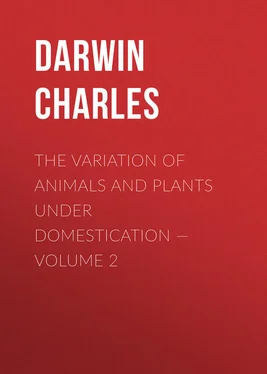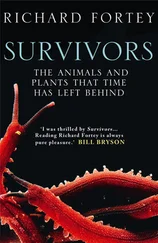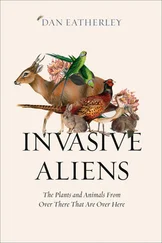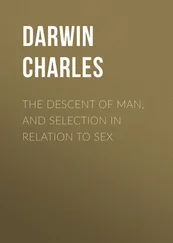Charles Darwin - The Variation of Animals and Plants under Domestication — Volume 2
Здесь есть возможность читать онлайн «Charles Darwin - The Variation of Animals and Plants under Domestication — Volume 2» — ознакомительный отрывок электронной книги совершенно бесплатно, а после прочтения отрывка купить полную версию. В некоторых случаях можно слушать аудио, скачать через торрент в формате fb2 и присутствует краткое содержание. Жанр: foreign_antique, foreign_prose, на английском языке. Описание произведения, (предисловие) а так же отзывы посетителей доступны на портале библиотеки ЛибКат.
- Название:The Variation of Animals and Plants under Domestication — Volume 2
- Автор:
- Жанр:
- Год:неизвестен
- ISBN:нет данных
- Рейтинг книги:3 / 5. Голосов: 1
-
Избранное:Добавить в избранное
- Отзывы:
-
Ваша оценка:
- 60
- 1
- 2
- 3
- 4
- 5
The Variation of Animals and Plants under Domestication — Volume 2: краткое содержание, описание и аннотация
Предлагаем к чтению аннотацию, описание, краткое содержание или предисловие (зависит от того, что написал сам автор книги «The Variation of Animals and Plants under Domestication — Volume 2»). Если вы не нашли необходимую информацию о книге — напишите в комментариях, мы постараемся отыскать её.
The Variation of Animals and Plants under Domestication — Volume 2 — читать онлайн ознакомительный отрывок
Ниже представлен текст книги, разбитый по страницам. Система сохранения места последней прочитанной страницы, позволяет с удобством читать онлайн бесплатно книгу «The Variation of Animals and Plants under Domestication — Volume 2», без необходимости каждый раз заново искать на чём Вы остановились. Поставьте закладку, и сможете в любой момент перейти на страницу, на которой закончили чтение.
Интервал:
Закладка:
CHAPTER 2.XIV
INHERITANCE continued. — FIXEDNESS OF CHARACTER — PREPOTENCY — SEXUAL LIMITATION — CORRESPONDENCE OF AGE.
FIXEDNESS OF CHARACTER APPARENTLY NOT DUE TO ANTIQUITY OF INHERITANCE. PREPOTENCY OF TRANSMISSION IN INDIVIDUALS OF THE SAME FAMILY, IN CROSSED BREEDS AND SPECIES; OFTEN STRONGER IN ONE SEX THAN THE OTHER; SOMETIMES DUE TO THE SAME CHARACTER BEING PRESENT AND VISIBLE IN ONE BREED AND LATENT IN THE OTHER. INHERITANCE AS LIMITED BY SEX. NEWLY-ACQUIRED CHARACTERS IN OUR DOMESTICATED ANIMALS OFTEN TRANSMITTED BY ONE SEX ALONE, SOMETIMES LOST BY ONE SEX ALONE. INHERITANCE AT CORRESPONDING PERIODS OF LIFE. THE IMPORTANCE OF THE PRINCIPLE WITH RESPECT TO EMBRYOLOGY; AS EXHIBITED IN DOMESTICATED ANIMALS: AS EXHIBITED IN THE APPEARANCE AND DISAPPEARANCE OF INHERITED DISEASES; SOMETIMES SUPERVENING EARLIER IN THE CHILD THAN IN THE PARENT. SUMMARY OF THE THREE PRECEDING CHAPTERS.
In the last two chapters the nature and force of Inheritance, the circumstances which interfere with its power, and the tendency to Reversion, with its many remarkable contingencies, were discussed. In the present chapter some other related phenomena will be treated of, as fully as my materials permit.
FIXEDNESS OF CHARACTER.
It is a general belief amongst breeders that the longer any character has been transmitted by a breed, the more fully it will continue to be transmitted. I do not wish to dispute the truth of the proposition that inheritance gains strength simply through long continuance, but I doubt whether it can be proved. In one sense the proposition is little better than a truism; if any character has remained constant during many generations, it will be likely to continue so, if the conditions of life remain the same. So, again, in improving a breed, if care be taken for a length of time to exclude all inferior individuals, the breed will obviously tend to become truer, as it will not have been crossed during many generations by an inferior animal. We have previously seen, but without being able to assign any cause, that, when a new character appears, it is occasionally from the first constant, or fluctuates much, or wholly fails to be transmitted. So it is with the aggregate of slight differences which characterise a new variety, for some propagate their kind from the first much truer than others. Even with plants multiplied by bulbs, layers, etc., which may in one sense be said to form parts of the same individual, it is well known that certain varieties retain and transmit through successive bud-generations their newly-acquired characters more truly than others. In none of these, nor in the following cases, does there appear to be any relation between the force with which a character is transmitted and the length of time during which it has been transmitted. Some varieties, such as white and yellow hyacinths and white sweet-peas, transmit their colours more faithfully than do the varieties which have retained their natural colour. In the Irish family, mentioned in the twelfth chapter, the peculiar tortoiseshell-like colouring of the eyes was transmitted far more faithfully than any ordinary colour. Ancon and Mauchamp sheep and niata cattle, which are all comparatively modern breeds, exhibit remarkably strong powers of inheritance. Many similar cases could be adduced.
As all domesticated animals and cultivated plants have varied, and yet are descended from aboriginally wild forms, which no doubt had retained the same character from an immensely remote epoch, we see that scarcely any degree of antiquity ensures a character being transmitted perfectly true. In this case, however, it may be said that changed conditions of life induce certain modifications, and not that the power of inheritance fails; but in every case of failure, some cause, either internal or external, must interfere. It will generally be found that the organs or parts which in our domesticated productions have varied, or which still continue to vary, — that is, which fail to retain their former state, — are the same with the parts which differ in the natural species of the same genus. As, on the theory of descent with modification, the species of the same genus have been modified since they branched off from a common progenitor, it follows that the characters by which they differ from one another have varied, whilst other parts of the organisation have remained unchanged; and it might be argued that these same characters now vary under domestication, or fail to be inherited, from their lesser antiquity. But variation in a state of nature seems to stand in some close relation with changed conditions of life, and characters which have already varied under such conditions would be apt to vary under the still greater changes consequent on domestication, independently of their greater or less antiquity.
Fixedness of character, or the strength of inheritance, has often been judged of by the preponderance of certain characters in the crossed offspring between distinct races; but prepotency of transmission here comes into play, and this, as we shall immediately see, is a very different consideration from the strength or weakness of inheritance. (14/1. See 'Youatt on Cattle' pages 92, 69, 78, 88, 163; and 'Youatt on Sheep' page 325. Also Dr. Lucas 'L'Hered. Nat.' tome 2 page 310.) It has often been observed that breeds of animals inhabiting wild and mountainous countries cannot be permanently modified by our improved breeds; and as these latter are of modern origin, it has been thought that the greater antiquity of the wilder breeds has been the cause of their resistance to improvement by crossing; but it is more probably due to their structure and constitution being better adapted to the surrounding conditions. When plants are first subjected to culture, it has been found that, during several generations, they transmit their characters truly, that is, do not vary, and this has been attributed to ancient characters being strongly inherited: but it may with equal or greater probability be consequent on changed conditions of life requiring a long time for their cumulative action. Notwithstanding these considerations, it would perhaps be rash to deny that characters become more strongly fixed the longer they are transmitted; but I believe that the proposition resolves itself into this, — that characters of all kinds, whether new or old, tend to be inherited, and that those which have already withstood all counteracting influences and been truly transmitted, will, as a general rule, continue to withstand them, and consequently be faithfully inherited.
PREPOTENCY IN THE TRANSMISSION OF CHARACTER.
When individuals, belonging to the same family, but distinct enough to be recognised, or when two well-marked races, or two species, are crossed, the usual result, as stated in the previous chapter, is, that the offspring in the first generation are intermediate between their parents, or resemble one parent in one part and the other parent in another part. But this is by no means the invariable rule; for in many cases it is found that certain individuals, races, and species, are prepotent in transmitting their likeness. This subject has been ably discussed by Prosper Lucas (14/2. 'Hered. Nat.' tome 2 pages 112-120.), but is rendered extremely complex by the prepotency sometimes running equally in both sexes, and sometimes more strongly in one sex than in the other; it is likewise complicated by the presence of secondary sexual characters, which render the comparison of crossed breeds with their parents difficult.
It would appear that in certain families some one ancestor, and after him others in the same family, have had great power in transmitting their likeness through the male line; for we cannot otherwise understand how the same features should so often be transmitted after marriages with many females, as in the case of the Austrian Emperors; and so it was, according to Niebuhr, with the mental qualities of certain Roman families. (14/3. Sir H. Holland 'Chapters on Mental Physiology' 1852 page 234.) The famous bull Favourite is believed (14/4. 'Gardener's Chronicle' 1860 page 270.) to have had a prepotent influence on the shorthorn race. It has also been observed (14/5. Mr. N.H. Smith 'Observations on Breeding' quoted in 'Encyclop. of Rural Sports' page 278.) with English racehorses that certain mares have generally transmitted their own character, whilst other mares of equally pure blood have allowed the character of the sire to prevail. A famous black greyhound, Bedlamite, as I hear from Mr. C.M. Brown "invariably got all his puppies black, no matter what was the colour of the bitch;" but then Bedlamite "had a preponderance of black in his blood, both on the sire and dam side."
Читать дальшеИнтервал:
Закладка:
Похожие книги на «The Variation of Animals and Plants under Domestication — Volume 2»
Представляем Вашему вниманию похожие книги на «The Variation of Animals and Plants under Domestication — Volume 2» списком для выбора. Мы отобрали схожую по названию и смыслу литературу в надежде предоставить читателям больше вариантов отыскать новые, интересные, ещё непрочитанные произведения.
Обсуждение, отзывы о книге «The Variation of Animals and Plants under Domestication — Volume 2» и просто собственные мнения читателей. Оставьте ваши комментарии, напишите, что Вы думаете о произведении, его смысле или главных героях. Укажите что конкретно понравилось, а что нет, и почему Вы так считаете.












